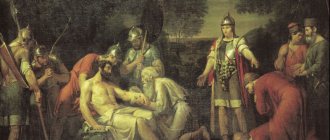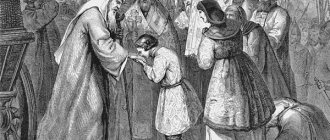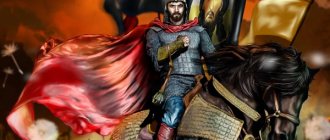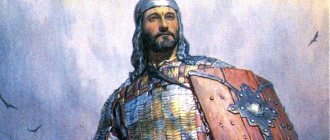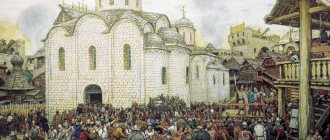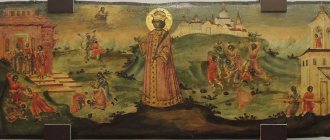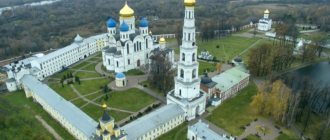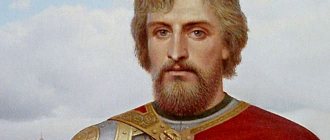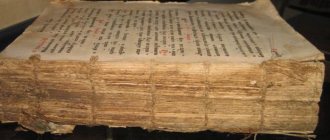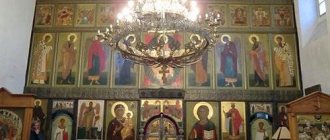| St. Euphrosyne of Moscow, blessed princess |
Euphrosyne
, in the world
Evdokia
(c. 1354 - 1407), blessed princess of Moscow, venerable Memory May 17, May 19 together with the blessed. book Demetrius Donskoy, July 7, in the Cathedrals of Moscow and Radonezh Saints.
In the world, Evdokia Dmitrievna, was born around 1354 [1] in the family of the Suzdal prince Dimitri Konstantinovich and his wife Anna.
On January 18, 1366, with the blessing of St. Alexy, Metropolitan of Moscow, Evdokia’s marriage took place with the Grand Duke of Moscow Dmitry Ivanovich. The wedding was solemnly celebrated according to the customs of those years in Kolomna. This marriage was of great importance for the fate of the Moscow state, cementing the union of the Moscow and Suzdal principalities.
This marriage took place at a difficult time. The forty-year period of relative calm in Rus' was ending: the time of almost continuous wars with numerous enemies - external and internal - was coming. In addition to the constant confrontation with external enemies - the Horde and Lithuania, the bloody rivalry of the Russian principalities continued.
In addition, almost in the very year of Prince Dimitri’s marriage to Evdokia, a “pestilence” was raging in Moscow, people were dying in the thousands, and the crying and lamentations of orphaned people could be heard along the Moscow streets. This misfortune was joined by another one - a terrible fire in Moscow.
Moscow had barely recovered from the ashes when in 1368 the Lithuanian prince Olgerd besieged the Kremlin, in which the Grand Duke and Princess, Metropolitan Alexy and the boyars secluded themselves. And again Moscow was burning, again the groans and cries of Moscow residents were heard, being beaten by the Lithuanians. The entire Moscow land was devastated.
The princess rightfully shared with the Grand Duke the feat of the struggle for the liberation of Rus' from the Mongol-Tatar yoke - with fervent prayers and deeds of love. In memory of the victory on the Kulikovo Field, Evdokia built a temple inside the Moscow Kremlin in honor of the Nativity of the Blessed Virgin Mary.
The invasion of the Tatar Khan Tokhtamysh in 1382 became a new terrible test for Moscow and the entire Russian land. Dimitri Ivanovich left to gather an army, first to Pereslavl, and then to Kostroma, leaving the Grand Duchess in Moscow. Because of the danger of taking Moscow, the Grand Duchess and her children and Metropolitan Cyprian barely managed to leave the city walls, after which Evdokia followed the prince. On the way, she was barely captured. After three days of siege, Tokhtamysh’s troops took Moscow and burned the city, after which they turned most of the Russian lands into ashes.
In 1383, Dimitri Ivanovich had to appear before Tokhtamysh to defend the khan’s rights to the great reign. Because of Tokhtamysh’s extreme anger, they decided to send the Grand Duke’s eldest son, Vasily, who was about 13 years old, to the Horde. Evdokia released her son and thereby doomed herself to two years of suffering - her son was detained in the Horde as a hostage. In addition to tribute, Tokhtamysh demanded a ransom of 8 thousand rubles for Vasily. The amount at that time was huge and the devastated Moscow principality could not pay the entire amount. Therefore, Vasily had to live in captivity of the khan for two long years, after which he managed to escape. On May 19, 1389, Grand Duke Dimitri Ivanovich died at the fortieth year of his life.
Dimitri Ivanovich handed over the throne to his son Vasily, bequeathing that his mother be his co-ruler. The Grand Duchess refrained from direct participation in state affairs. Even during her husband’s life, she lived a truly Christian life, and after his death she led a strictly monastic ascetic life, dressed in a hair shirt, and wore heavy chains under her luxurious grand-ducal clothes. Even in front of her loved ones she did not want to reveal her exploits; She organized dinner parties in the Grand Duke's palace, but she herself did not touch the dishes, eating Lenten food.
But ridiculous rumors began to circulate around Moscow, affecting the honor of the widow - the princess. These rumors reached the sons. The princes, although they loved their mother and did not believe the slander, still could not help but be embarrassed. One of them, Yuri, turned to his mother with a question about the slander defaming her. Then the princess gathered all her sons and took off part of the grand ducal clothes - the children saw that the ascetic had become so thin from fasting and labors that her body was withered and blackened and “the flesh stuck to the bones.” Yuri and his other brothers asked their mother for forgiveness and wanted to take revenge for the slander. But their mother forbade them to even think about revenge. She said that she would gladly endure humiliation and human slander for the sake of Christ, but seeing the embarrassment of the children, she decided to reveal her secret to them.
Every day Evdokia could be found either in one of the churches or in the monastery. Remembering her late husband, she constantly made contributions to monasteries and donated money and clothing to the poor. The sons of the Grand Duchess grew up, she began to think about a monastery in which she could devote herself entirely to God. In the heart of Moscow - in the Kremlin - she is building a new convent in honor of the Ascension. We chose a place near the Florovsky Gate. From here she saw off, here she met her husband, returning from the Kulikovo field. Near the gate there was a grand-ducal tower, burned during the invasion of Tokhtamysh. On this site of the former princely home, the Grand Duchess erected monastic cells. At the same time, she built several churches and monasteries in Pereslavl-Zalessky.
One of the most significant events in the spiritual history of Russia is associated with the name of Grand Duchess Evdokia. In 1395, Tamerlane’s army approached the borders of Rus', which horrified the entire people. Grand Duke Vasily Dmitrievich, thanks to the influence of his mother, showed fortitude, gathered an army and went out to meet the enemy. The people, strengthened by faith in God's intercession, prayed to God together with their princess. Evdokia made deep prayers for the deliverance of Rus' from destruction. The prayer of the righteous woman was heard by God. On the advice of his mother, Vasily Dimitrievich ordered to bring the miraculous Vladimir Icon of the Mother of God from Vladimir to Moscow. On August 26, 1395, Grand Duchess Evdokia with her sons, the metropolitan, the clergy, the boyars, and many assembled residents of Moscow met the icon of the Mother of God on Kuchkovo Field. On that very day and hour, Tamerlane, in a sleepy vision, saw the “Radiant Woman”, surrounded by radiance and many “lightning-fast warriors” menacingly rushing forward. On the advice of his mentors, Tamerlane ordered the troops to turn away from the borders of Rus'.
In 1407, after a vision of the Archangel Michael, who foreshadowed her imminent death, Princess Evdokia decided to accept monasticism, which she had striven for all her life. At her request, an image of the Archangel Michael was painted and placed in the Kremlin church in honor of the Nativity of the Blessed Virgin Mary.
On May 17, 1407, she took monastic vows with the name Euphrosyne in the wooden Church of the Ascension. According to legend, on the day of the Grand Duchess's tonsure, 30 people were healed of various diseases.
And three days later, on May 20, the foundation stone of a new stone church in honor of the Ascension of Christ took place, where the Grand Duchess determined her resting place. But she did not get to see the completion of construction.
She died on July 7, 1407 at the age of 54. They buried Saint Euphrosyne in front of a large crowd of people in the place of the church that was under construction, indicated by her, where she rested until 1929, bestowing grace-filled help to everyone who came with faith to her multi-healing relics.
In 1922, the shrine and the canopy over the relics were removed in order to extract precious metals from it. The relics of St. Euphrosyne remained in a stone tomb under the floor of the cathedral.
In 1929, by decision of the government, the destruction of the buildings of the Ascension Monastery began. Museum staff tried to save the necropolis. The basement of the Judgment Chamber of the Archangel Cathedral was chosen for its placement. The white stone tomb of St. Euphrosyne was damaged and they could not remove it entirely from the ground. The relics of the saint were saved from destruction; they were located along with other remains from burials in two white stone tombs of the 15th century. When opening the burials, among the remains of St. Euphrosyne, in addition to small pieces of fabric from the shroud, they found scraps of her leather monastic belt with embossed images of the twelve feasts and captions for them. These shrines, together with the vessels for oil that were in the coffins, are kept in the collections of the Kremlin museums.
On May 28, 2008, with the blessing of Patriarch Alexy II of Moscow and All Rus', the relics of the Holy Blessed Princess Euphrosyne of Moscow were transferred to the chapel of the martyr Huar of the Archangel Cathedral of the Moscow Kremlin. The Patriarch in his speech called this event “the second discovery of the relics of St. Euphrosyne of Moscow.” The transfer of the relics was preceded by the work of a commission in which spiritual and secular scientists worked together under the leadership of Archbishop Alexy of Orekhovo-Zuevsky. During the work of the commission, the relics of the saint were discovered [2].
On July 13, 2015, by decision of the Holy Synod of the Russian Orthodox Church, the joint memory of the faithful Prince Dimitry Donskoy and Princess Evdokia was established on May 19, like other saints who showed the image of a married family [3].
Family stories with Tutta Larsen: Evdokia Moskovskaya and Dmitry Donskoy
Share
13-year-old Evdokia was a thin, pale girl with chiseled, beautiful features. Brought up in strictness, she looked with fear at the broad-shouldered, dark-haired young man with fiery eyes. Dmitry was only three years older than her, but looked like an adult, confident man. Evdokia already knew that he should become her husband. But she didn’t know that he would unite fragmented Rus' against the Tatar-Mongols and become famous under the name of Dmitry Donskoy.
Their marriage was concluded for political reasons, and before the wedding, the bride and groom saw each other only once. Fragile Evdokia was timid in front of the stately Dmitry, both when he walked her down the aisle and when he took her to his princely inheritance - Moscow. Seeing the city devastated after the raids of the Golden Horde, and the people weakened by the plague, Evdokia almost fell into despair. All this was so different from my native Suzdal with its majestic churches! Dmitry noticed his young wife’s distress and hastened to console her. In a quiet, calm voice, he convinced her that with God's help they would restore Moscow, and it would become more beautiful than before. He sincerely believed in his words. Evdokia also believed him. And having met his determination, dedication, desire to help disadvantaged people and protect the state, the girl realized that true love was awakening in her heart.
Growing up, Evdokia increasingly looked at her husband. His stern face, framed by a thick black beard, seemed frightening to his many enemies. But the wife saw how fair and reasonable her husband was with his subordinates and how gentle and loving he was alone with her. Every time the prince went to battle or meet with the formidable envoys of the Golden Horde, Evdokia’s heart trembled with fear that her husband would not return. But he always returned - both after confrontations with other princes, and from the Tatar-Mongol khans, and from the Battle of Kulikovo. Dmitry entered the city with a calm, measured step - he knew that he could rely on his wife, who wisely ruled the city in his absence, replacing his mother as a subject.
Over the years, the feelings between Evdokia and Dmitry only strengthened, although this union initially had only political goals. Their marriage was destined to become an example of marital love and support - the young prince, who successfully fought the Horde, was followed by all of Rus'.
The couple had 12 children, and the last of them was born when Dmitry lay dying, broken by a serious illness. A tearful Evdokia brought the baby to her husband, hoping that this could awaken new strength in Dmitry. But everything was useless - a few days later the Grand Duke died...
After the death of her husband, Evdokia found herself among the most influential people in Rus'. However, she did not need either power or recognition. She raised her younger children and devoted herself to God. Thanks to her care, white-stone monasteries were built, at her request, Theophanes the Greek and Andrei Rublev painted churches, and she ordered the production of the Trinity Chronicle. The princess plunged headlong into works of mercy and charity, trying to drown out the pain of losing her husband.
Until old age, Evdokia retained her spiritual beauty. Many men wooed the beautiful widow, but she refused everyone - there was only room in her heart for one man, and that was Dmitry. The offended “suitors” began to spread rumors discrediting Evdokia. They were so plausible that even her own children could not stand it and came to their mother, asking: who does she receive in her chambers at night? Instead of answering, Evdokia showed them the heavy chains on her emaciated body, and the sons became embarrassed. How could they doubt that she was faithful to her husband's memory? After this incident, no one else dared to denigrate the bright name of Evdokia of Moscow.
She outlived Dmitry by 18 years. Feeling the approach of death, she wished to become a nun, and when she was tonsured she was named Euphrosyne. For a huge number of good deeds, she was glorified among the saints of the Orthodox Church. The kind princess was not forgotten by the grateful townspeople, to whom she gave her last strength during her reign. Today, the Venerable Euphrosyne is revered as one of the heavenly patrons of Moscow, as is her husband, Prince Dmitry Donskoy, revered among the saints.
Prayers
Troparion, tone 8
Because of your earthly widowhood, you lost sight of the Heavenly Bridegroom/ and lived as an ascetic in the princely palace,/ after which you left both the palace and your children/ for God’s sake, Venerable Euphrosyne,/ and entered the monastery you created,/ and in a different manner you showed many deeds ,/ and by the grace of God you crowned your holy life with a blessed death./ And now those who stand before Christ God, // pray for our souls to be saved.
Troparion, tone 5
From your youth, chosen by God to be a saint, / leaving the bright palace of the prince, / you turned away to the monastery you created, / and, having swum through the abyss of the sea of life, / now with the Angels you sing hymns to Christ God. / Pray to Him unceasingly, venerable one, / for the monastery to remain preserved. , created by you, / and gives us peace and great mercy.
Children
Evdokia and Dmitry Donskoy had at least 12 children:
- Daniil Dmitrievich (c. 1370-September 15, 1379).
- Vasily I of Moscow (September 30, 1371 - February 27, 1425).
- Sofya Dmitrievna. Married Fyodor Olegovich, Prince of Ryazan (reigned 1402–1427).
- Yuri Dmitrievich, Duke of Zvenigorod and Galich (November 26, 1374 - June 5, 1434). Vasily II of Moscow demanded the Moscow throne against his nephew.
- Maria Dmitrievna (d. May 15, 1399). married Lengvenis.
- Anastasia Dmitrievna. Married to Ivan Vsevolodich, Prince Kholm.
- Simeon Dmitrievich (d. September 11, 1379).
- Ivan Dmitrievich (d. 1393).
- Andrei Dmitrievich, Prince of Mozhaisk (August 14, 1382 - July 9, 1432).
- Peter Dmitrievich, Prince Dmitrov (July 29, 1385 - August 10, 1428).
- Anna Dmitrievna (born January 8, 1387). Married to Yuri Patrikevich. Her husband was the son of Patrikey, Prince Starodub and his wife Helen. His paternal grandfather was Narimantas. The marriage strengthened his role as a boyar attached to Moscow.
- Konstantin Dmitrievich, Prince of Pskov (May 14 / May 15, 1389 - 1433).
Faith in God is the foundation of the Russian state
In the 14th century, during the reign of the grand ducal couple, the process of spiritual revival of our Fatherland began. Christian holiness became the ideal for Muscovite Rus'.
“Faith in God, inner spiritual strength, help and intercession of saints—this is the foundation on which the building of a new, unified Russian state began to be built,” writes Leonid Bamblevsky. — Orthodoxy begins to spread from northern Rus'. The Trinity Monastery becomes the center, the mentor and confessor of all Rus' is St. Sergius of Radonezh. And if the monastery of St. Sergius became the spiritual center, then at the social level the “builders” of the building of the Russian state were the Grand Dukes Dmitry Ioannovich and Evdokia Dmitrievna.”
In 1380, during a formidable battle with the Horde hordes, Muscovite Rus' passed the test of strength only thanks to the strong union of spiritual and secular power. And today he should serve as an example for us to follow.
Heritage
On August 15, 2007, the Holy Synod of the Russian Orthodox Church established the Order of Saint Euphrosyne
them. Evdokia, the first Moscow noblewoman to enter monasticism. The prize was established to commemorate the 600th anniversary of the death of Euphrosyne. According to the synod decree (decree), new awards will be given to women for their special contribution to strengthening spiritual and moral traditions in society, developing the social activities of the church, maintaining relations between church and state or church and society, as well as in other areas of activity for the improvement of the Orthodox faith . The Order of Saint Euphrosyne will become the second female decoration of the Russian Orthodox Church after the Order of Saint Olga.[3]
References
- ^ a b c
"Saint Euphrosyne Princess (Evdokia) of Moscow", Orthodox Church in America - Byzantium, Faith and Power (1261-1557)
, (Helen S. Evans, ed.), 2004, Metropolitan Museum of Art/Yale University Press, p. 165, ISBN 1588391140 - Interfax (August 21, 2007), the Russian Orthodox Church has established another women's prize - the Order of Saint Euphrosyne, the first saint of Moscow.
, received August 26, 2007
The first monument in Russia
Sculptor Dmitry Kukkolos , wanting to show people that it is family that makes Russia strong, depicted Dmitry Donskoy and Euphrosyne of Moscow with two children: their first-born, Prince Vasily, is standing in front, and baby Yuri is held in his mother’s arms.
The monument to the holy spouses was solemnly opened on November 19, 2013 near the only Russian church of St. Euphrosyne of Moscow in Kotlovka. And perhaps not all passers-by know that in front of them are the parents of not two, but 12 beautiful children!
From the children's book by Anastasia Gerasimova , “Reverend Euphrosyne of Moscow,” children can learn that the Battle of Kulikovo was won by Dmitry Donskoy after the blessing of St. Sergius of Radonezh, and great help in defeating the enemy was provided by Evdokia of Moscow, who, together with her people, fervently prayed to God and the Mother of God for the victory of Russian soldiers over the Mongol-Tatars.
For adults, we can recommend Leonid Bamblevsky’s “The Return of Evdokia. Life of Saint Eudokia, in the monastery of Euphrosyne, Grand Duchess of Moscow."
biography
Evdokia was the daughter of Dmitry Konstantinovich, Grand Duke of Suzdal[1] and Nizhny Novgorod and Vasilisa of Rostov.
Her maternal grandparents were Konstantin Vasilievich, Prince of Rostov and Maria of Moscow. Maria was the daughter of Ivan I of Moscow and his first wife Elena.
On January 18, 1366, Evdokia married Grand Duke Dmitry Donskoy. In 1382, she remained in Moscow in the absence of her husband, while the army of Khan Tokhtamysh was approaching the capital. After the birth of her son Andrei Dmitrievich, she tried to leave Moscow, but was detained by Muscovites, who agreed to let her go only after long negotiations.
Help for fire victims
Evdokia did an incredible amount for Muscovites (her name means “benevolence”). After the death of her husband, all worries about the state and family fell on her fragile shoulders. She took upon herself the care of the poor, the sick, the elderly, widows, and orphans. With her personal funds, she built majestic stone churches and monasteries, shelters and houses for fire victims, helping both a merchant who lost his property in a fire and a poor orphan.
Not afraid to stain the prince’s clothes, immediately after the fire she went to clear up the Moscow ashes in order to console the fire victims and share their misfortune with them.
“How a ruthless element can destroy a large flourishing city in an instant! How many people became fire victims then... Who could help all these unfortunate, disadvantaged people? - writes Leonid Bamblevsky in the book “The Return of Evdokia”. — The gazes of thousands of people with hope rushed towards the prince’s mansion. And the prince and his wife did not leave their subjects in trouble.”
“Are we not the princes of this city? - Dmitry turned to Evdokia. “Didn’t the Lord entrust us with the lives of the people living in it?” Isn't it time to open the princely treasuries and look at the wealth that our fathers and grandfathers collected? Maybe it will help the fire victims?
In response to these words, young Evdokia happily agreed with her husband. “She personally delved into the needs of each fire victim, trying not to leave anyone without attention and her care. Sparing no effort, she walked between the ashes until nightfall, handing out money and things, approving everyone with kind words. For many, she became a mother or sister, tenderly caring and helping in the most difficult times.” Who is capable of this today?
Subsequently, so that the tragedy of the fire in the first year of their reign would not be repeated, Dmitry and Evdokia began to create a majestic Kremlin of white stone. This was the first such large-scale stone construction in the history of our Fatherland,” we read in Leonid Bamblevsky’s book. And by God’s providence, the holy relics of Evdokia are in the Moscow Kremlin.
Grand Duchess Evdokia was able to fulfill her long-standing dream of monasticism only before her death. She took monastic vows with the name Euphrosyne, which means “joy.” The monastic name suited her very well, for her life was a great joy for the entire Russian Land.
Despite the many trials sent by God that strengthened her faith, her entire life was filled with joy, consisting of matters of national importance, of unceasing prayer, which she loved since childhood, of works of mercy and love for her husband and children.
